10 Things We Learned From WWE Royal Rumble 1988
The Hogan and Andre contract signing...
More than 30 years have passed since the then-World Wrestling Federation would televise what would soon become the most highly-anticipated gimmick match that the company would ever sanction: the Royal Rumble. Jaded fans come out of their autumn doldrums and post-holiday blahs with the sense of renewal that comes with the new year, and with that new year, amplified by both their speculative wonder of the forthcoming Rumble, as well as the wistful joy of Rumbles past.
And it all had to start somewhere. On Sunday night, January 24, 1988, WWE produced what is accepted as the inaugural Royal Rumble event, and not on pay-per-view either - this one was broadcast live on the USA Network, as though it were a Saturday Night's Main Event companion piece. With Vince McMahon and Jesse "The Body" Ventura on the call, the Sunday evening special would boast two attractions: the titular match (which only featured 20 entrants), and a contract signing between Hulk Hogan and Andre the Giant, building to their colossal showdown on NBC's "The Main Event" just 12 nights later.
It wouldn't be the most momentous of Royal Rumbles, but it's a charming slice of history, an agreeable-enough event that doubles as a curiosity for younger fans, answering the question what was the first Royal Rumble broadcast like?
 WWE
WWE
Hacksaw Jim Duggan is often cited as the very first Royal Rumble match winner, and that's true - as far as *televised* Rumbles go. You would have to go back almost four months, to 4 October 1987, to get the scoop on who the first *real* Royal Rumble winner was, when WWE ran a dry run of the match at a house show in St. Louis.
The actual first Rumble match winner was The One Man Gang, outlasting a field of 12 to 14 wrestlers (sources differ), last eliminating the Junkyard Dog. Other match entrants included Demolition, Davey Boy Smith, Cowboy Bob Orton, among others. The match was to determine who would receive a WWE Championship match against Hulk Hogan at the next St. Louis event a month later, but in a boneheaded mistake, it was announced at intermission that fans could buy tickets to see Hogan face Gang at the next month's card, spoiling the Rumble finish. When Gang eliminated JYD to win, fans reacted with genuine outrage. Oops.
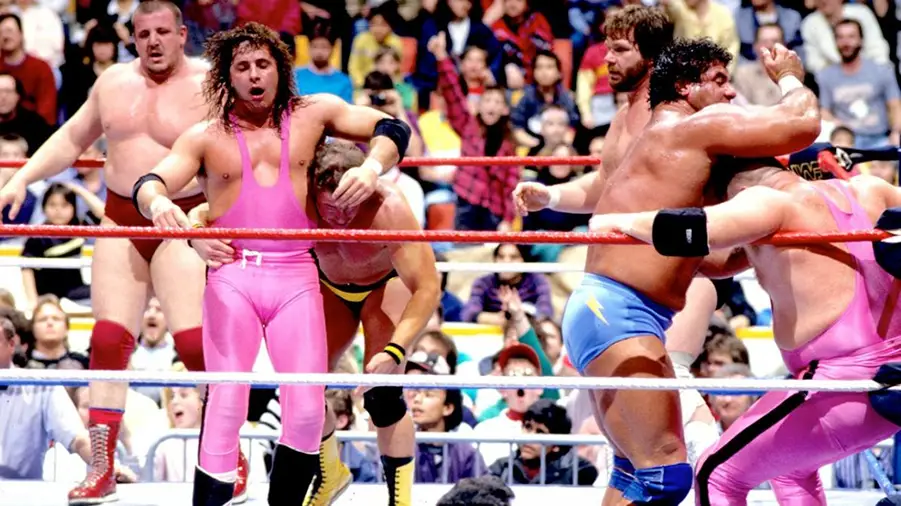 WWE
WWE
You may recall how Survivor Series was born out of WWE's desire to muscle Jim Crockett/NWA/WCW out of the PPV market, when Crockett brought Starrcade to the medium for Thanksgiving 1987. Survivor Series would bury Starrcade once most PPV outlets sided with the stronger WWE, and it wouldn't be the last time that WWE counter-programmed a Crockett PPV.
The Royal Rumble aired the same night as NWA's second PPV card, Bunkhouse Stampede, only this time, the PPV providers didn't have to choose between the two companies - WWE was putting their offering on basic cable, where more viewers could access it. Bunkhouse Stampede would be a flop unto itself, as Dusty Rhodes' victory in the titular match, a snafu with the wrong time printed on the tickets, *and* the fact that the event was held on Long Island (home of many bunkhouses) were all cited in assessing the misfire.
 WWE
WWE
As noted in the introduction, the event was called by Vince McMahon and Jesse Ventura, the diametrically-opposed talking heads that memorably sniped back and forth through Saturday Night's Main Event and WWE Superstars episodes throughout the mid-to-late-eighties. Ventura's presence was inconspicuous, but McMahon's was, as it was usually Gorilla Monsoon that partnered with Ventura for pay-per-view-calibre broadcasts.
Monsoon was originally tabbed to call the event alongside Ventura, but would actually be sidelined due to a mild heart attack. Monsoon would end up missing both the Rumble, the live televised Madison Square Garden card that aired one night later, and portions of the upcoming WWE Wrestling Challenge tapings, with McMahon filling in for him in those spots as well.
 WWE
WWE
If you're one of those fans clamouring today for WWE to institute a Women's Tag Team division, you may wanna check out the WWE of the Hulkamania era. Not only were there (seldom-seen) Women's Tag Team titles, but there were some genuinely-gifted gals competing for them. The 1988 Royal Rumble sees The Jumping Bomb Angels (Itsuki Yamazaki and Noriyo Tateno) defeat reigning champions The Glamour Girls (Judy Martin and Leilani Kai) in a two out of three falls match to win the gold.
Somewhat incredibly, this would be the only form of Women's title that would change hands at any Royal Rumble for more than two decades. It wouldn't be until the 2009 event that Melina would defeat Beth Phoenix to capture the Women's Championship, the first women's singles title change at any Rumble.
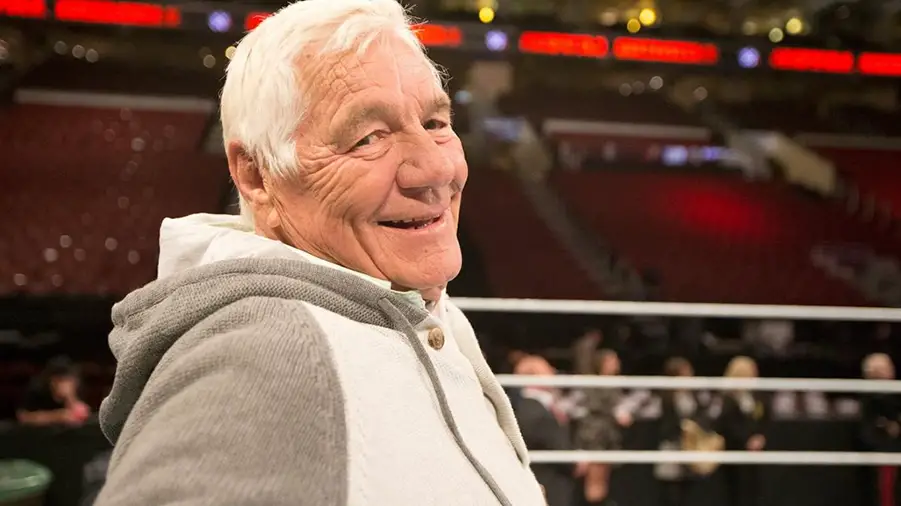 WWE
WWE
It's been oft-cited that the Royal Rumble was the brainchild of Pat Patterson. Patterson based the Rumble concept on the popular battle royals that took place in the San Francisco territory throughout the seventies, usually for a purported cash prize of some sort. Patterson knew that a battle royal-style match with some kind of twist could have intrigue, and he devised the Rumble.
But Patterson ran into a doubter: Vince McMahon himself. McMahon felt that the extended duration of the match wouldn't jive with the attention span of the viewer, but Patterson was insistent. When the two met with NBC executive and producer Dick Ebersol to plan the still-shapeless January 24 TV special, Patterson pitched the Rumble concept, and Ebersol loved it. He imagined the drama of counting down to each ensuing entrant, figuring the pop-up drama would offset any issues with the match's length. So we have Dick Ebersol to thank for the Rumble's ongoing existence.
 WWE
WWE
Hard as it is to believe sometimes, the composition of the Royal Rumble match is meticulously detailed, carefully planned out by an individual or two. Entries, eliminations, spotlight moments, etc, are structured for the wrestlers to follow, as well as the commentary team and the production staff. For many years, Patterson was the one who organized the Rumble, and he was considered the absolute best at it.
Years later in his memoirs, Accepted: How the First Gay Superstar Changed WWE, Patterson noted that on the day of the Rumble, a number of the match participants were freaking out over the sheer amount of detail in the match, the depth of his instructions. Nothing in wrestling with this much complexity had ever been attempted in front of a nationwide TV audience. To watch the match, it looks rather smooth and simple, which tells you just how much detail can go into even something that feels basic.
 WWE
WWE
From 1989 onward, WWE felt comfortable bloating the Rumble match to at least 30 entrants, without any attention span-related apprehension. For 1988, as noted, they went with just 20 competitors, a class that includes 10 future WWE Hall of Famers (as well as a few possible down-the-line candidates). Maybe they could've run with 30 guys, but there were some WWE talents that were busy elsewhere that night.
Yes, strange as it may sound, WWE actually ran a separate house show opposite the Royal Rumble. While the Rumble crew was in Hamilton, ON, a seven-match live event was taking place over in Halifax, NS. That card included a Honky Tonk Man/Randy Savage main event, a Brutus Beefcake/Greg Valentine semi-main, with the likes of Demolition, The Fabulous Rougeau Brothers, and Koko B Ware working underneath. Such wrestlers could've helped to make a pretty snazzy 30-man match.
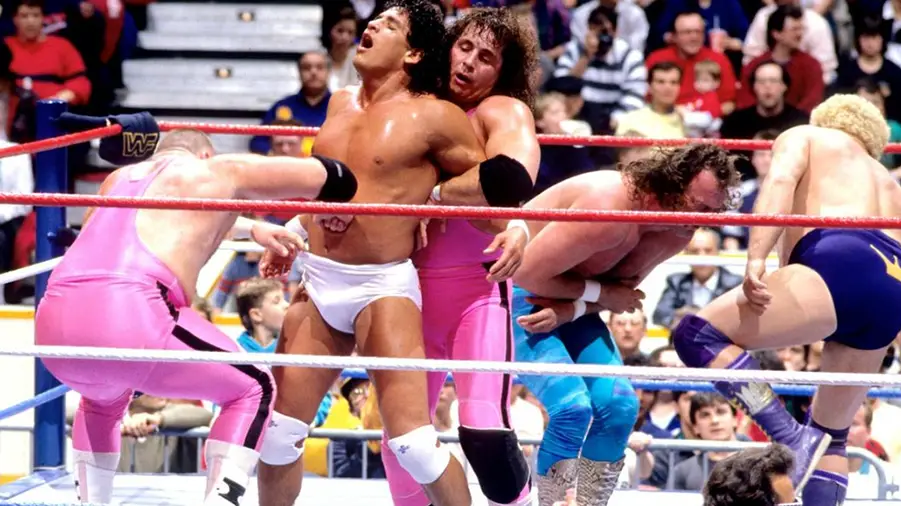 WWE
WWE
Watch enough Royal Rumbles, and you'll notice that the front-end of the match will boast some of the more skilful performers available. Such gifted technicians are counted on to help pace the match, give out instructions, and just generally maintain order. Such wrestlers are usually able to last a while, having the endurance to go deep into the skirmish, while remaining effective as ring generals.
The 1988 match began with two such respected workers: Bret Hart and Tito Santana. It would be The Hitman that would become the match's first-ever duration king, lasting 25 minutes and 42 seconds before being eliminated by Don Muraco, the match's 11th entrant. Seeing as the match only lasted 33 minutes, Hart made it through 75 per cent of the fray, which would be the equivalent of going 45 minutes in an hour-long Rumble.
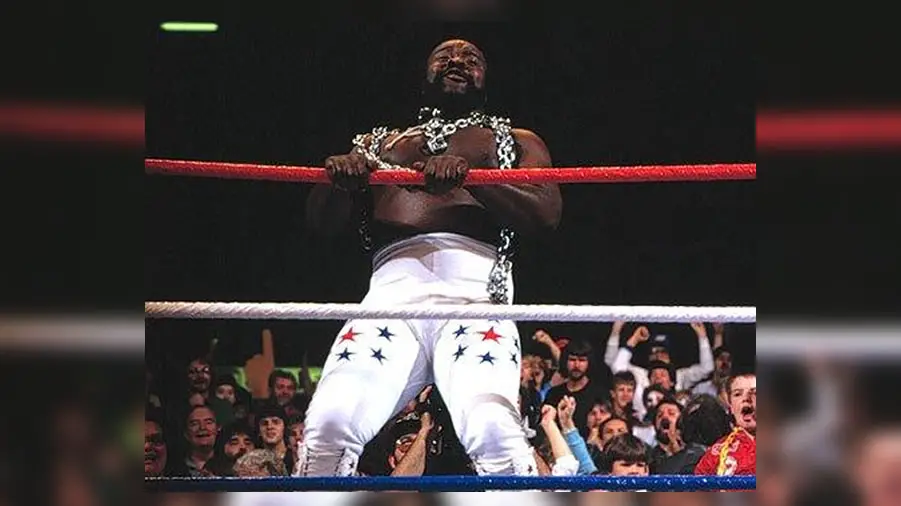 WWE
WWE
The entrants' list for the 1988 Royal Rumble match is definitely a who's who for the time, though even by 1988 standards, it feels a wee bit antiquated. Sure, future World Champions like Bret Hart and The Ultimate Warrior are in the match, as are wrestling royals like Jake Roberts, Jim Duggan, and Harley Race, but for the most part, the match really does have "1988" written all over it.
Of the 20 men who entered the fray, 10 of them would never compete in another Rumble match. Race, Butch Reed, Jim Brunzell, B. Brian Blair, Boris Zhukov, Don Muraco, Hillbilly Jim, Sam Houston, Danny Davis, and Junkyard Dog would see their only televised Rumble action here in 1988. The likes of Reed, both Killer Bees, Muraco, and Dog would all be effectively gone from the company by the time the 1989 Rumble rolled around, while Race, Houston and Davis finished up as WWE wrestlers either at or not long after the 1989 event.
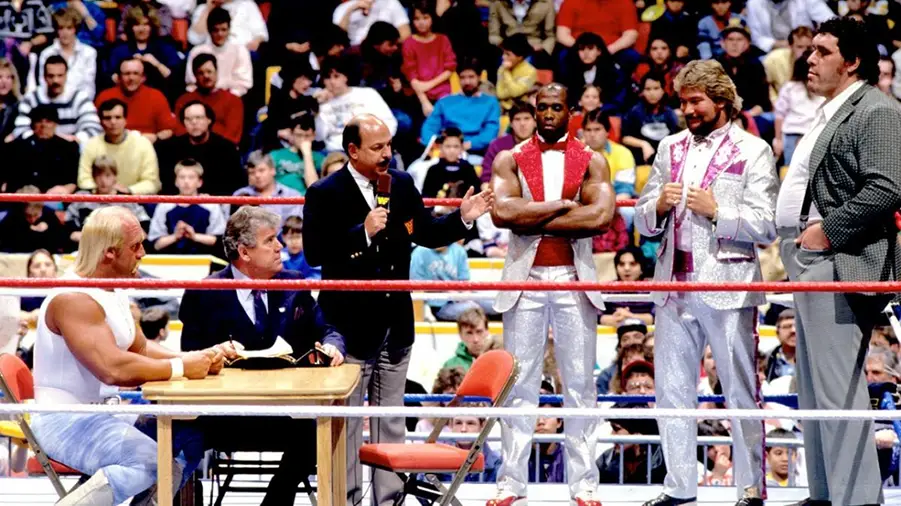 WWE
WWE
Bunkhouse Stampede didn't stand too much of a chance. Hulk and Andre signing the contract for their WWE Championship rematch, as well as the lure of this newfangled thing called the Royal Rumble, found an audience in a major way, the latter of which would certainly motivate WWE to put the well-received on pay-per-view the following year.
The 1988 Rumble did an 8.2 TV rating, the highest for any cable wrestling program to that point. To put that in perspective, WWE would have to be more than a year deep into the Attitude Era before any Raw episode could sniff that number. With eight percent of American households tuning in to see WWE's latest creation. Guess Vince should listen to Patterson more often, no?
And it all had to start somewhere. On Sunday night, January 24, 1988, WWE produced what is accepted as the inaugural Royal Rumble event, and not on pay-per-view either - this one was broadcast live on the USA Network, as though it were a Saturday Night's Main Event companion piece. With Vince McMahon and Jesse "The Body" Ventura on the call, the Sunday evening special would boast two attractions: the titular match (which only featured 20 entrants), and a contract signing between Hulk Hogan and Andre the Giant, building to their colossal showdown on NBC's "The Main Event" just 12 nights later.
It wouldn't be the most momentous of Royal Rumbles, but it's a charming slice of history, an agreeable-enough event that doubles as a curiosity for younger fans, answering the question what was the first Royal Rumble broadcast like?
10. Well, Actually...
 WWE
WWEHacksaw Jim Duggan is often cited as the very first Royal Rumble match winner, and that's true - as far as *televised* Rumbles go. You would have to go back almost four months, to 4 October 1987, to get the scoop on who the first *real* Royal Rumble winner was, when WWE ran a dry run of the match at a house show in St. Louis.
The actual first Rumble match winner was The One Man Gang, outlasting a field of 12 to 14 wrestlers (sources differ), last eliminating the Junkyard Dog. Other match entrants included Demolition, Davey Boy Smith, Cowboy Bob Orton, among others. The match was to determine who would receive a WWE Championship match against Hulk Hogan at the next St. Louis event a month later, but in a boneheaded mistake, it was announced at intermission that fans could buy tickets to see Hogan face Gang at the next month's card, spoiling the Rumble finish. When Gang eliminated JYD to win, fans reacted with genuine outrage. Oops.
9. Easy Choice
 WWE
WWEYou may recall how Survivor Series was born out of WWE's desire to muscle Jim Crockett/NWA/WCW out of the PPV market, when Crockett brought Starrcade to the medium for Thanksgiving 1987. Survivor Series would bury Starrcade once most PPV outlets sided with the stronger WWE, and it wouldn't be the last time that WWE counter-programmed a Crockett PPV.
The Royal Rumble aired the same night as NWA's second PPV card, Bunkhouse Stampede, only this time, the PPV providers didn't have to choose between the two companies - WWE was putting their offering on basic cable, where more viewers could access it. Bunkhouse Stampede would be a flop unto itself, as Dusty Rhodes' victory in the titular match, a snafu with the wrong time printed on the tickets, *and* the fact that the event was held on Long Island (home of many bunkhouses) were all cited in assessing the misfire.
8. Change Of Voice
 WWE
WWEAs noted in the introduction, the event was called by Vince McMahon and Jesse Ventura, the diametrically-opposed talking heads that memorably sniped back and forth through Saturday Night's Main Event and WWE Superstars episodes throughout the mid-to-late-eighties. Ventura's presence was inconspicuous, but McMahon's was, as it was usually Gorilla Monsoon that partnered with Ventura for pay-per-view-calibre broadcasts.
Monsoon was originally tabbed to call the event alongside Ventura, but would actually be sidelined due to a mild heart attack. Monsoon would end up missing both the Rumble, the live televised Madison Square Garden card that aired one night later, and portions of the upcoming WWE Wrestling Challenge tapings, with McMahon filling in for him in those spots as well.
7. Angelic In Victory
 WWE
WWEIf you're one of those fans clamouring today for WWE to institute a Women's Tag Team division, you may wanna check out the WWE of the Hulkamania era. Not only were there (seldom-seen) Women's Tag Team titles, but there were some genuinely-gifted gals competing for them. The 1988 Royal Rumble sees The Jumping Bomb Angels (Itsuki Yamazaki and Noriyo Tateno) defeat reigning champions The Glamour Girls (Judy Martin and Leilani Kai) in a two out of three falls match to win the gold.
Somewhat incredibly, this would be the only form of Women's title that would change hands at any Royal Rumble for more than two decades. It wouldn't be until the 2009 event that Melina would defeat Beth Phoenix to capture the Women's Championship, the first women's singles title change at any Rumble.
6. Royal Resistance
 WWE
WWEIt's been oft-cited that the Royal Rumble was the brainchild of Pat Patterson. Patterson based the Rumble concept on the popular battle royals that took place in the San Francisco territory throughout the seventies, usually for a purported cash prize of some sort. Patterson knew that a battle royal-style match with some kind of twist could have intrigue, and he devised the Rumble.
But Patterson ran into a doubter: Vince McMahon himself. McMahon felt that the extended duration of the match wouldn't jive with the attention span of the viewer, but Patterson was insistent. When the two met with NBC executive and producer Dick Ebersol to plan the still-shapeless January 24 TV special, Patterson pitched the Rumble concept, and Ebersol loved it. He imagined the drama of counting down to each ensuing entrant, figuring the pop-up drama would offset any issues with the match's length. So we have Dick Ebersol to thank for the Rumble's ongoing existence.
5. So Much To Remember
 WWE
WWEHard as it is to believe sometimes, the composition of the Royal Rumble match is meticulously detailed, carefully planned out by an individual or two. Entries, eliminations, spotlight moments, etc, are structured for the wrestlers to follow, as well as the commentary team and the production staff. For many years, Patterson was the one who organized the Rumble, and he was considered the absolute best at it.
Years later in his memoirs, Accepted: How the First Gay Superstar Changed WWE, Patterson noted that on the day of the Rumble, a number of the match participants were freaking out over the sheer amount of detail in the match, the depth of his instructions. Nothing in wrestling with this much complexity had ever been attempted in front of a nationwide TV audience. To watch the match, it looks rather smooth and simple, which tells you just how much detail can go into even something that feels basic.
4. Where Is Everybody?
 WWE
WWEFrom 1989 onward, WWE felt comfortable bloating the Rumble match to at least 30 entrants, without any attention span-related apprehension. For 1988, as noted, they went with just 20 competitors, a class that includes 10 future WWE Hall of Famers (as well as a few possible down-the-line candidates). Maybe they could've run with 30 guys, but there were some WWE talents that were busy elsewhere that night.
Yes, strange as it may sound, WWE actually ran a separate house show opposite the Royal Rumble. While the Rumble crew was in Hamilton, ON, a seven-match live event was taking place over in Halifax, NS. That card included a Honky Tonk Man/Randy Savage main event, a Brutus Beefcake/Greg Valentine semi-main, with the likes of Demolition, The Fabulous Rougeau Brothers, and Koko B Ware working underneath. Such wrestlers could've helped to make a pretty snazzy 30-man match.
3. Built To Last
 WWE
WWEWatch enough Royal Rumbles, and you'll notice that the front-end of the match will boast some of the more skilful performers available. Such gifted technicians are counted on to help pace the match, give out instructions, and just generally maintain order. Such wrestlers are usually able to last a while, having the endurance to go deep into the skirmish, while remaining effective as ring generals.
The 1988 match began with two such respected workers: Bret Hart and Tito Santana. It would be The Hitman that would become the match's first-ever duration king, lasting 25 minutes and 42 seconds before being eliminated by Don Muraco, the match's 11th entrant. Seeing as the match only lasted 33 minutes, Hart made it through 75 per cent of the fray, which would be the equivalent of going 45 minutes in an hour-long Rumble.
2. One And Done
 WWE
WWEThe entrants' list for the 1988 Royal Rumble match is definitely a who's who for the time, though even by 1988 standards, it feels a wee bit antiquated. Sure, future World Champions like Bret Hart and The Ultimate Warrior are in the match, as are wrestling royals like Jake Roberts, Jim Duggan, and Harley Race, but for the most part, the match really does have "1988" written all over it.
Of the 20 men who entered the fray, 10 of them would never compete in another Rumble match. Race, Butch Reed, Jim Brunzell, B. Brian Blair, Boris Zhukov, Don Muraco, Hillbilly Jim, Sam Houston, Danny Davis, and Junkyard Dog would see their only televised Rumble action here in 1988. The likes of Reed, both Killer Bees, Muraco, and Dog would all be effectively gone from the company by the time the 1989 Rumble rolled around, while Race, Houston and Davis finished up as WWE wrestlers either at or not long after the 1989 event.
1. The World Is Watching
 WWE
WWEBunkhouse Stampede didn't stand too much of a chance. Hulk and Andre signing the contract for their WWE Championship rematch, as well as the lure of this newfangled thing called the Royal Rumble, found an audience in a major way, the latter of which would certainly motivate WWE to put the well-received on pay-per-view the following year.
The 1988 Rumble did an 8.2 TV rating, the highest for any cable wrestling program to that point. To put that in perspective, WWE would have to be more than a year deep into the Attitude Era before any Raw episode could sniff that number. With eight percent of American households tuning in to see WWE's latest creation. Guess Vince should listen to Patterson more often, no?
